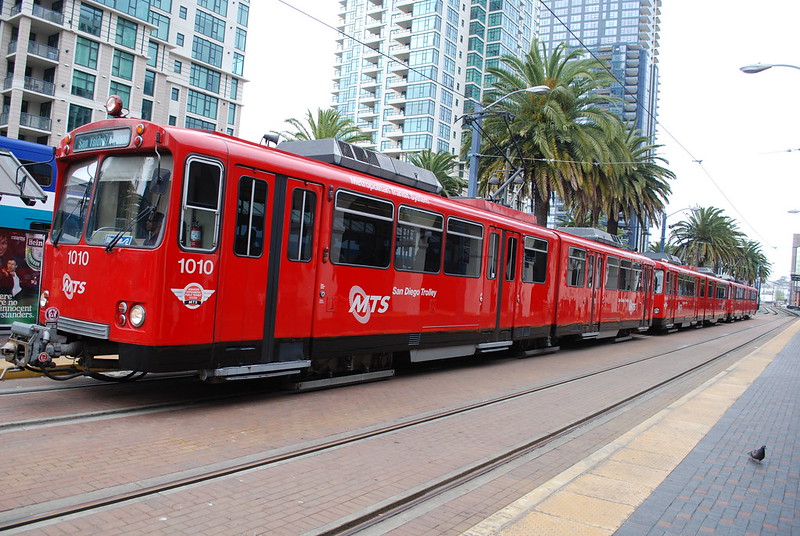Capturing the Real Value of Transit-Oriented Development

Over the past few decades, California has made historic investments in urban mass transit, as demand for transit-served neighborhoods has grown. Yet these investments are undermined by poor local planning around transit stations, with zoning codes often blocking the mixed-use, infill housing development that can help capture the full value of public investments in transit.
Worse, the streets around these stations are often hostile to pedestrians, bicyclists, and transit riders. As a result, transit-served communities across California are missing out on the benefits of new transit, which could accommodate much more affordable housing, while reducing traffic pollution and congestion.
In a new report for Circulate San Diego, researchers Jesse O’Sullivan and Colin Parent consider how such barriers affect San Diego’s Mid-Coast Trolley Extension, which provided connections to the University of California—San Diego. While focused on this project, their work holds clear implications for transit projects across the state.
Key takeaways:
- Zoning around the proposed Mid-Coast Trolley Extension stations prohibits the mixed-use, infill housing development needed to fully leverage the project.
- Likewise, streets around the proposed Mid-Coast Trolley Extension stations are designed to be hostile to pedestrians and bicyclists.
- The absence of transit-only lanes further defeats the value of these transit investments, since buses often sit stuck in car traffic.
Over the past few decades, California has spent billions of taxpayer dollars building out the state’s mass transit infrastructure. Many of these projects are still actively underway, from the West Sacramento light rail extension to the West Los Angeles Purple Line extension. Down in San Diego, the Blue Line was recently extended to connect the University of California—San Diego, significantly improving transit access for many tens of thousands of students, faculty, and staff.
Yet take a walk around any of the new stations, and you’ll mostly find empty parking lots and aging strip malls. This is by design: the current University Community Plan leaves little “zoned capacity” for more homes or businesses – meaning that it’s illegal to expand access to these publicly-funded transit stations to new residents or business owners.
That is to say, the underutilization of lots around the Mid-Coast Trolley Extension isn’t a sign of a lack of demand, but the result of out-of-date zoning policies. Early outreach work suggests that these policies are out of line with the preferences of residents, who favor higher-density development near transit.
O’Sullivan and Parent suggest that planners leverage the ongoing University Community Plan update to remove such barriers and stimulate new infill development. This includes new transit-oriented housing, as well as new transit-accessible biotech laboratories and offices.
But the land use is not the only problem: Along this walk around University City, you will also likely find a public realm hostile to the pedestrians, bicyclists, and bus riders likely to use the new transit infrastructure. Streets in and around the neighborhood are designed for maximum car speed and throughput, and lack basic safety features that protect pedestrians and cyclists from traffic crashes — a poor fit for a neighborhood increasingly built around transit that undermines multimodal access to the new stations.
Adding insult to injury, the transit stations are not served by dedicated transit lanes, meaning buses regularly get snarled in traffic. These delays hinder transit performance and harm transit riders, whose top concerns are typically reliability and frequency.
O’Sullivan and Parent urge the city to expand the neighborhood’s network of dedicated bus lanes and protected bicycle lanes. Likewise, the authors recommend investments in pedestrian safety and comfort, such as curb extensions, street trees, and more high-visibility crosswalks.
While O’Sullivan and Parent focus on San Diego’s Mid-Coast Trolley Extension, many of the reforms they advocate for can be applied to mass transit investments across the state. If market signals are any indication, many California households prefer transit-accessible housing, as do many prospective employers. Yet many transit stations across the Golden State remain flanked by massive parking lots and unsafe, high-speed arterial streets.
As their report shows, our state’s recent transit investments have been held back by anachronistic zoning codes and hostile street design. The good news is that, with prudent planning, we can easily do better.
Flickr photo of the San Diego Trolley by Joe Wolf